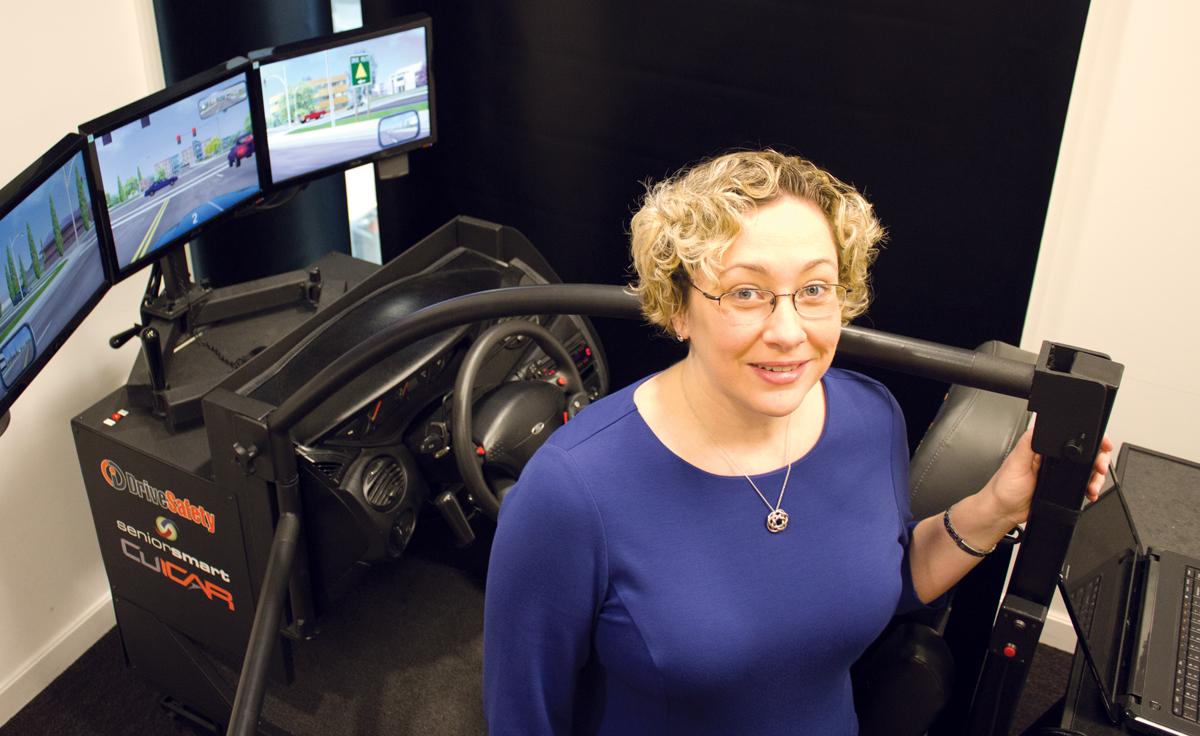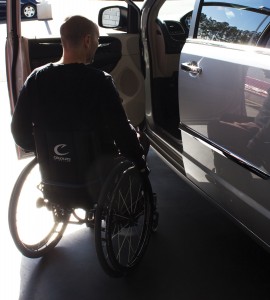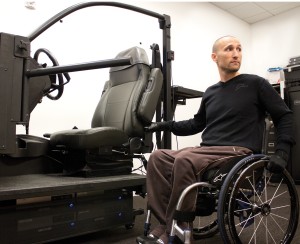drive able
Lauren J. Bryant
Johnell Brooks finds ways to keep wounded warriors, wreck-prone rookies, and slowing seniors safer on the road.

Johnell Brooks's simulator, with its realistic road scenes, lets drivers master new skills in a lab before they try them in traffic.
From the sweaty-palmed sixteen-year-old who just passed his driving test to the slow-moving eighty-six-year-old who still takes herself to the doctor, driving is the key to independence in America. Yet few, if any, of us prepare for the end of driving.
“As you age, you prepare for so many things,” says Johnell Brooks, associate professor in the Department of Automotive Engineering. “You prepare for where you want to live, you prepare for financial security. Few people, however, plan for how driving is going to change as they age, or for the end of their driving careers.”
A Midwesterner by birth (she comes from Nebraska), Brooks moved to South Carolina while in high school and became a three-time Clemson University graduate. With a Ph.D. in psychology (yes, her full-time appointment is in automotive engineering), Brooks is a human-factors psychologist who studies “individuals’ capabilities and limitations in order to make systems that are safe, efficient, and satisfying for the user.”
In Brooks’s case, those systems are automotive. Her goal is to “do anything I can to keep people driving safely as long as possible.” Why focus on driving? “I like it,” she says simply, “because everyone can relate.” By “everyone,” she means not only adolescents and senior citizens, but also injured veterans, women, short people or tall, thin, obese—in other words, “people, who come in all different shapes and sizes with all different abilities.”
From psych to engineering
When Brooks started out as a faculty member at Clemson, she was part of the psychology department, where she used the university’s driving simulator to carry out her projects. An actual full-size vehicle parked on the third floor of Clemson’s Brackett Hall, the simulator was connected to computers and surrounded by large, standing screens. Using this setup, Brooks and her colleagues and students conducted driving-related research including studies of visual limitations during night driving and of distracted driving due to multitasking.
Nearly every simulator project needed heavy instrumentation that required close collaboration with Clemson’s engineering faculty and students. Eventually, after several years of working “hand-in-hand” with engineering, Brooks moved from the psychology department to the Department of Automotive Engineering in January 2012. She is also a member of the Clemson University International Center for Automotive Research (CU-ICAR), a 250-acre research campus that puts Clemson among the top ten automotive colleges and universities in the United States, according to the “car people” website www.edmunds.com.
Along the way, she developed a collaboration with physicians and occupational therapists at Roger C. Peace Rehabilitation Hospital (RCP) of the Greenville Health System. The driving-simulator scenarios Brooks had developed were ideal for helping seniors trying to re-learn how to drive after significant medical events, but the university’s driving simulator proved too big, expensive, and complicated to work in a clinical setting. So Brooks worked with the Utah-based company DriveSafety to design and develop a smaller, sleeker unit, now called the Drive-Safety CDS-250 Clinical Driving Simulator.
“We had wanted to create a simulation system optimized for use by clinicians with their patients,” says Douglas Evans, CEO of DriveSafety. “Dr. Brooks and her team brought unique insight and expertise to help make it possible.”
The colloaboration has resulted in intellectual property, which, through the support of the Clemson University Research Foundation (CURF), has been licensed to DriveSafety for commercialization.
Making data work for patients
Today, Brooks’s major laboratory is based in the RCP Hospital, about thirty miles from the Clemson campus. Her research projects begin on the university side, where she and her team, including primary collaborator Paul Venhovens, collaborate with DriveSafety to develop scenarios to test various driving-related problems. After deciding what components a scenario will have and what metrics will be used to provide objective feedback, the scenario is tested with volunteers on the university side, then transitioned over to the hospital system. That transition, Brooks says, is a “very iterative process.”

Zeke Massie can drive a racing car, but climbing aboard a standard passenger vehicle is sometimes a challenge. With Brooks’s team taking notes, Massie tries out new models at a local dealership, describing obstacles to access. Brooks will use the results to advise automakers.
Brooks explains that computerized driving simulators have sensors that collect constant streams of data about an individual’s driving performance as he or she navigates various digital driving scenarios. But in a clinical setting, that vast amount of research data may prove to be of little use.
“Academics think a ton of data is a wonderful thing,” Brooks says. “But how do you present complex data to patients in a way that’s meaningful? Or to clinicians who may not have a background in statistics?”
The solutions Brooks and her colleagues have come up with are usually visual. “In the clinic, it is important to make the driving performance information visual and easily understandable,” she notes. “We transform the information and have it instantly appear on the screen at the end of a clinic driving session in a meaningful and valuable way.” For example, for drivers being evaluated on how they drive within a traffic lane, the team came up with a simple color-coding scheme.
“We made color-coded sections of the lane: green for the center zone, yellow if someone is veering toward the edge, red if any part of the vehicle is touching the edge,” Brooks explains. “Instead of talking about centimeters and ‘deviations from the center position,’ therapists can talk about how many times a person was in the red zone.”
The simulator that Brooks helped design is now in use in twenty-six research facilities and clinical settings—three in Europe, two in Australia, two in Hawaii, and nineteen in the continental United States. A couple of the simulators are in university settings, and one is in a pharmacy school where it’s used to study the effects of prescriptions on driving performance. But most of the simulators are in military and VA hospitals. That came as a surprise to Brooks.
“When we started developing the simulator,” she explains, “we thought the aging population would be the major users. But it turns out that the majority of the simulators are in military hospitals where a huge portion of the patients are wounded warriors who have blast injuries, loss of lower limbs, traumatic brain injury, or post-traumatic stress disorder.”
The realization that physical and occupational therapists in military and veterans’ hospitals were using the simulator steered Brooks’s research in a new direction. For the last couple of years, she says, she and Clemson engineering students have been using the simulator primarily to develop and test designs for hand controls. Hand controls are adaptive devices used to drive a car, instead of using one’s legs and feet to control the gas and brakes.
Brooks says the DriveSafety simulator is a perfect tool for engineers, therapists, and most of all, patients, to test how different hand-control designs work. For one thing, she contends, the simulator is a lot safer. Typically, patients learned to use hand controls by driving in big parking lots, according to Brooks. “But just think about where military hospitals are located; most of them are in big cities,” she says. “So the veterans were having to learn how to use the controls in congested, busy parking lots and frequently in high-density traffic.”
With the simulator, military veterans try different designs of hand controls and get comfortable with operating the gas and brake on hills and around curves in the digital scenarios, before they ever go out on a real road.
“They can really get the nuances down of how hard to press for gas and brake and which direction you press,” Brooks says. “It’s just so different for someone who has already learned to drive with their feet to have to transfer that knowledge to their hands.”
From racetrack to lab
To further develop the simulator for use by veterans with lower limb injuries, Brooks turns to Zeke Massie, whom she calls a “subject-matter expert.” A retired Marine Corps veteran, Massie has been paralyzed from the armpits down for eighteen years, following a motorcycle accident. He lives in Atlanta, Georgia, where he’s also been involved in motorsports since 1997.

Zeke Massie, a retired Marine Corps veteran, travels from Atlanta to work with Brooks and her team in the lab. He brings experience Brooks and her students don’t have. “The Clemson students are really smart kids, but they don’t live the way I do. I’ve been in my chair for almost as long as a lot of these kids have been alive,” he says.
Massie and Brooks met through a Clemson student of Brooks’s who also is a friend of Massie’s. When the student described Massie’s involvement in motorsports, Brooks knew she wanted to meet him. They eventually connected at a racetrack in Atlanta, and a collaboration was born.
Recalling his own days of having to learn how to drive again, Massie says, “When Johnell told me she was working on a simulator, I thought it was such a good idea, a super idea.”
Massie now visits Clemson several times a year. His initial visits were focused on helping Brooks and her students improve how people in wheelchairs would transfer onto the driving simulator’s seat. More recently, he’s been helping Brooks and her students with various projects including hand-control development, seat-belt design, and designs for cars that better accommodate wheelchair-to-car transfers. Massie says his biggest contribution is his life experience. “The Clemson students are really smart kids, but they don’t live the way I do. I’ve been in my chair for almost as long as a lot of these kids have been alive,” he says. “They have great ideas, but sometimes they are far from what is really useable. I know what works. I don’t want them to waste time going down the wrong track, so I get in there, and we brainstorm.”
Massie is enthusiastic about the community he’s found at Clemson. Working with Brooks’s automotive engineering students gives him hope, he says.
“These kids are engineers focused on cars,” he says, “and I hope by giving them as much information as I can, they’ll design cars that will really benefit the disabled community and make it better for everybody.”
For veterans who do not have lower limb injuries but do have TBIs or PTSD, the driving simulator is used in a different way, Brooks explains. She and her team members have developed scenarios that present these returning vet drivers with stress-inducing situations, but in the safety of the simulator. Scenarios that seem benign to civilian drivers—featuring things such as potholes, dead animals in the road, or large trucks boxing in a car stuck in traffic on an expressway—can be triggers for returning vets.
“Dead animals, potholes, or trash bags on the road’s shoulder don’t cause stress for a typical U.S. driver,” Brooks says, “but veterans expect IEDs. These soldiers who are reintegrating into civilian driving and the therapists who work with them have really motivated us to develop these scenarios in the simulator.”
A woman’s point of view
Expanding the ways engineering students—and future engineers—think about drivers is absolutely central to Brooks’s work. “My primary goal is to make sure that our automotive engineering students realize they are not designing only for young healthy twenty-year-olds but for all people,” she says.

Connie Truesdail, a retired English teacher from Easley, South Carolina, is a test subject and advisor with a keen eye for detail—not only in the simulator but in the team’s research manuscripts.
Venhovens, who leads Deep Orange, Clemson’s innovative master’s program in automotive engineering, calls Brooks’s perspective an enrichment for the program. “Cars are operated by humans, and understanding the capabilities and limitations of the human operator or passengers and teaching graduate students how to evaluate and design vehicles from a human-factors perspective really needs to be part of every engineering education,” he says. “Without this aspect vehicles are just robotized machines that don’t get along well with their users.”
Being the only female faculty member in the automotive engineering department comes in handy in the “getting along well” regard. Brooks laughs as she describes trying to get her predominantly male students to consider automotive engineering from a woman’s point of view. For example, designing a car’s seat or the seat of a motorcycle takes on a whole new dimension.
“They have to figure out how to talk to women about the size of their bottoms in a way that is not going to result in getting slugged,” Brooks says. “How do you talk about a woman fitting comfortably on a seat, or getting on a motorcycle in India, for instance, where women sit sidesaddle wearing a sari?”
Brooks tells her male students to pretend they’re having a discussion with their girlfriend, mother, or grandmother. “When I ask them how they think that’s going to work,” she says, “that usually puts it in perspective. They usually answer with, ‘Ohhhhhhhhhhhh.’”
Blurred lines
A social scientist spanning the worlds of hospital clinics and research laboratories, Brooks believes it’s at “the intersection of different disciplines where the most interesting work happens. When we bring different fields together, we’re able to look at and solve problems with a broader perspective.”
By blurring the lines (the fuzzier the better, she says) between psychology, engineering, and medicine, Brooks has brought something unique to Clemson, to military hospitals, and to South Carolina’s automotive industry at large. Using the driving simulator and other tools, Brooks and her research partners can evaluate driving problems and automotive design features from the perspectives of an aging driver, a driver in a wheelchair, an obese driver, or a female driver, offering valuable data to hospital therapists and automotive manufacturers alike.
“Being a human-factors psychologist involved in a team like this, seeing the students think about how they need to design and apply concepts for different user groups, and seeing patients in the hospital use products and services we developed, has got to be the most rewarding job on the planet,” Brooks says.
Johnell Brooks is an associate professor of automotive engineering in the College of Engineering and Science. Paul Venhovens is the BMW Endowed Chair for Systems Integration at CU-ICAR and a SmartState Chair, South Carolina Center for Economic Excellence. Lauren J. Bryant is a science journalist based in Bloomington, Indiana. Photos by Neil Caudle.


